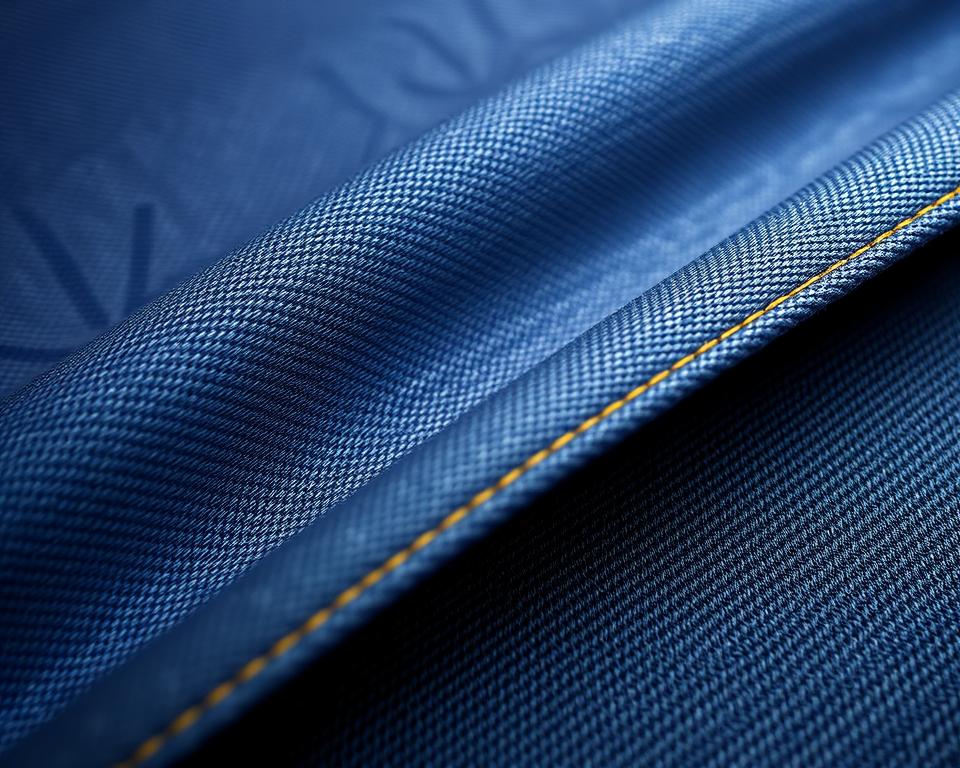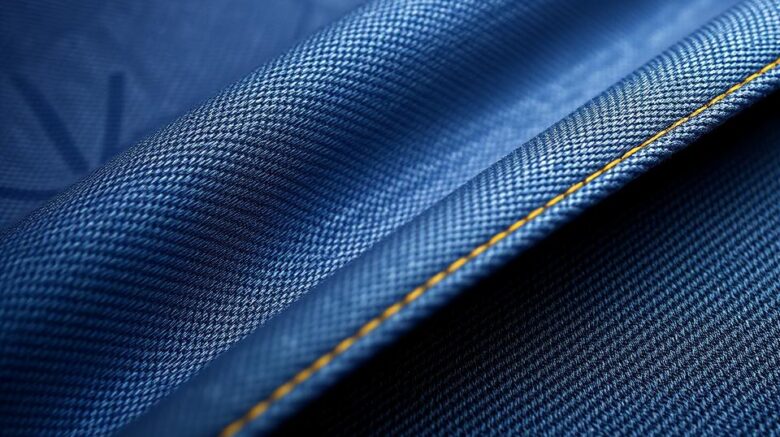Your Handbook to Superior denim Edge-to-Edge Textile
Have you ever wondered why some trousers feel like they’re designed for longevity a lifetime? Everything revolves around the materials and skill. Take, for instance, the increasing movement of superior selvedge. It’s not merely ordinary fabric—it exemplifies superiority and legacy.
Nowadays, a growing number of people are turning to these everlasting textiles for their robustness and iconic selvedge denim fabric allure. Whether you’re a home sewing sewist or a denim lover, there’s a unique quality about employing high-quality natural fiber and stitching. It’s not just about making trousers; it centers on crafting a narrative.
Here at Core Fabrics, we’ve assembled a selection of 14.25oz certified organic cotton and stretch options. These materials are tailor-made for a spectrum ranging from raw trousers to designer jacket designs. Eager to discover the universe of exceptional fabrics? Let’s dive in.
Defining Denim Selvedge Fabric?
Why do some trousers distinguish themselves with their distinctive, naturally edged edges? The key resides in the selvedge denim, a premium fabric renowned for its durability and vintage charm. Unlike standard textiles, this fabric is crafted with traditional methods that have proven their worth.
Understanding Selvedge Denim
Selvedge denim is produced with old-style shuttle looms, which produce slender widths of about 30-35 inches. These looms weave the textile in a manner that ensures self-finished borders, often accented with a distinctive red line. This method confirms the fabric is firmly crafted and extremely robust.
Current looms, in contrast, generate broader textile but do not offer the same level of artistry. Subtle irregularities in selvedge, like twists in the leg or uneven textures, are accepted as features of its character. This ideology, termed “wabi-sabi”, celebrates the beauty of natural flaws.
The Making of Selvedge Denim
The production of selvedge denim involves a exacting process. These looms weave the weft thread alternately, creating a compact and resilient material. Unlike modern methods with contemporary machines, which focus on rapid output over craftsmanship.
Brands like Karson Denim preserve time-honored Japanese weaving techniques from the 90s. They intentionally include anomalies to retain the true character of the fabric. Every item is graded on a four-point system, confirming it meets the peak requirements of excellence.
| Characteristic | Selvedge Denim | Contemporary Denim |
|---|---|---|
| Span | 30-35 inches | 60+ inches |
| Construction Technique | Classic Shuttle Loom | Modern Loom |
| Texture | Irregular, Flawed | Uniform |
| Durability | Exceptional | Standard |
“The allure of selvedge is found in its flaws—each flaw tells a story skill and legacy.”
The History of Selvedge Denim
Starting from modest origins to global acclaim, the story of these materials is rich and motivational. Originally developed as rugged attire in seventeenth-century France transformed into a symbol of classic elegance and artistry.
Beginnings in Craftsmanship
The origin of this fabric dates back to Nîmes, France, where it was referred to as “serge de Nîmes.” Originally designed for laborers, it was constructed with robust cotton and stitching. Its durability made it a favorite among laborers during the Gold Rush.
By the 20th century, it had become a staple for trousers. The closure of the Cone Mills White Oak factory served as a catalyst. This change enabled Japanese artisans to restore old-world weaving methods.

Advancements in Production
Following WWII, Japan adopted old-school American culture. Artisans repaired antique looms to produce true reproductions. This dedication to craftsmanship ensured the continuance of selvedge as a niche product.
In modern times, innovations from Italy and Turkey have brought forth sustainable blends and flexible options. These modernizations have widened the attraction of this everlasting fabric. Here at Core Fabrics, we source globally, from Montréal to Asia, to offer you the best excellence.
“The history of selvedge is a testament to the perennial merit of excellence and heritage.”
Reasons to Select Selvedge Denim?
What makes selvedge denim shine in the universe of superior materials? Its special characteristics and unmatched durability make it a favorite among aficionados and designers alike. Be it that you are making trousers or a tailored jacket, this fabric offers a mix of classic methods and modern appeal.
Characteristic Features of Selvedge
Selvedge denim is renowned for its dense construction, which improves tear resistance and fade potential. Unlike standard materials, selvedge denim material is produced using classic shuttle looms, yielding a denser and more durable material. This process ensures that all products boast a singular finish and individuality.
Notable attributes are:
- Textured, firm raw denim offers a contrast to laundered, relaxed stretch options.
- Through sanforization, sizes become reliable, while natural variants entail a shrink-to-fit adventure.
- Variants include 9.5oz Eco Finish to 14.25oz Organic, catering to diverse applications.
Sturdiness and Lifespan
One of the key attributes of selvedge denim is its enduring nature. The dense fabric structure not only increases durability but also allows for unique fading patterns over time. This renders it a treasured choice for those seeking enduring style.
Key points to consider:
- 12-14oz weights are ideal for structured jackets and jeans that soften with age.
- Opt for the 14.25oz True Indigo for traditional jean lifespan.
- Sustainable variants such as recycled cotton combined with indigo blends enhance eco-friendliness.
Within our range at Core Fabrics, diverse choices cater to distinct demands. Whether untreated or sanforized, every item is made to provide outstanding quality and performance.
Comparing Selvedge and Wide Denim
When it comes to crafting robust and fashionable apparel, the choice of material matters significantly. Two popular options are selvedge and wide denim, each possessing distinct traits. Comprehending their variances guides the best option for your creation.
Distinct Weaving Methods
Selvedge denim is woven on classic shuttle looms, resulting in narrow widths of 30-35 inches. This striped selvedge denim fabric method forms tightly woven edges, often accented with a characteristic red line. Wide denim, on the other hand, uses modern projectile looms, resulting in spans of 60+ inches.
Old-style shuttle looms yield roughly 3m per minute, while projectile looms can produce up to 30 meters per minute. This difference in speed impacts both the expense and the texture of the final product.
Benefits and Drawbacks
Selvedge denim is celebrated for its superior quality and strength. Its slender dimension makes it ideal for projects where exposed edges or decorative patches are required. However, it can be more expensive, generally priced at $23 per meter.
Wide denim is economical, ranging at $8 per half-meter. Its wider width cuts down on scrap, well-suited to big-scale works like furniture covering. However, it lacks the unique edge finish of selvedge.
| Feature | Selvedge Denim | Wide Denim |
|---|---|---|
| Span | 30-35 inches | 60+ inches |
| Method | Traditional Shuttle | Modern Projectile |
| Output | 3m per minute | 30m per minute |
| Cost | $23 per meter | $8 per half-meter |
For defined borders as seen in Grainline Thayer jackets, selvedge is favored. Conversely, wide denim is ideal for extensive projects due to its efficiency. Evaluate your project specifications to choose wisely.
Working with Selvedge Denim
Working with premium materials can elevate your sewing projects to the next level. Whether you are creating jeans, jackets, or skirts, understanding the basics of yardage, sewing techniques, and care ensures a professional finish. Let’s delve into the optimal use of this timeless material.
Material Requirements for Jeans and Jackets
It is essential to compute the correct fabric amount when designing your creation. For men’s jeans, you’ll need about 3-3.3 yards, accounting for potential defects and shrinkage. For trucker jackets, expect to use around 3.3 yards, while a skirt often needs 2 yards.
Innovative layout techniques can mitigate fabric flaws. Instead of cutting around defects, consider integrating them into your design for a unique look.
| Item | Fabric Needed |
|---|---|
| Men’s Jeans | 3–3.3 yards |
| Trucker Jacket | 3.3 yards |
| Skirt | 2 yards |
Advice for Sewing and Longevity
Using the right tools and techniques ensures a polished result. Opt for #70-110 pins and foot accessories designed for heavy materials. For contrast stitching, Gütermann rPET thread is a reliable choice.
Consider these extra tips:
- Employ a tailor’s clapper to achieve crisp creases without gloss.
- Core Fabrics’ denim kits include topstitch thread, rivets, and 9mm jeans buttons for a professional finish.
- Structured edges, essential for jackets, are best achieved with selvedge.
Correct care ensures your garments last longer. Use minimal washing and opt for air drying to preserve fabric quality. Adhering to these practices will sustain your creations for years.
To Summarize
Crafting with premium materials isn’t just about durability—it’s about creating something with character. Selvedge denim epitomizes this philosophy, blending artisanal charm with enduring excellence. Whether you’re sewing jeans or a structured jacket, this material tells a story with every stitch.
With Core Fabrics, unleashing your creative potential is effortless. Our swatch service lets you touch and test the fabric before deciding. Plus, enjoy free shipping on orders over $150 USD across North America.
Looking ahead, eco-friendly blends and vintage washes are shaping the future of cotton textiles. They open fresh avenues for merging sustainability with chic style.
Ready to dive into the world of premium materials? Begin your journey now and appreciate the merit of intentional crafting. Your subsequent creation may well become an enduring classic.
